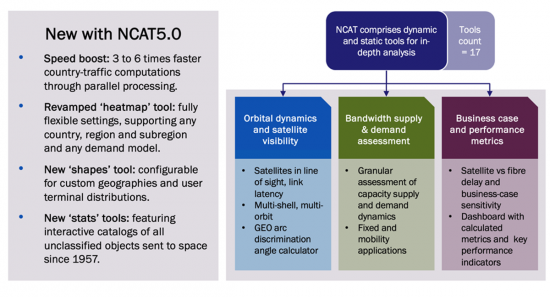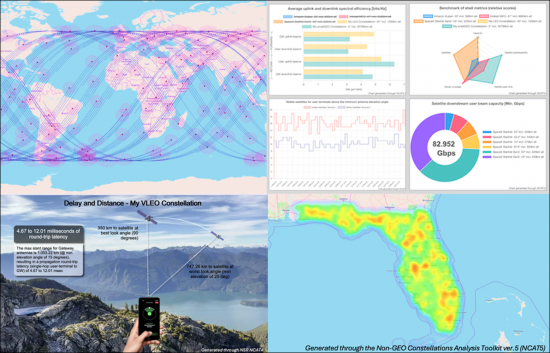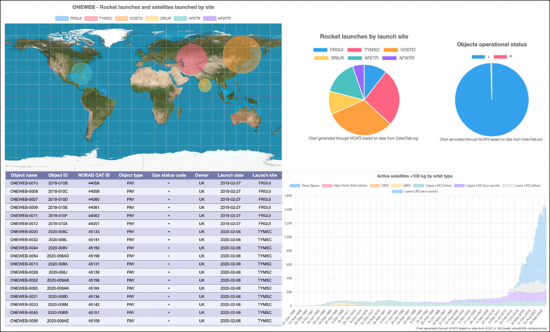 |
年間契約型資訊服務
商品編碼
1568193
非GEO衛星群分析工具包5.0Non-GEO Constellations Analysis Toolkit 5.0 |
||||||
非 GEO 衛星群分析工具包(NCAT)結合了資料集、分析和互動式視覺化,以評估 LEO(低地球軌道)和 MEO(中地球軌道)衛星衛星群的實際性能。

戰略家、商業和技術專業人士可以使用 NCAT 平台來分析 NGSO 衛星衛星群的性能及其對國家和地區的影響。
新發布的NCAT v5.0(NCAT5)以線上 Web 應用程式形式提供,提供了增強的工具,可用於細粒度評估頻寬供應和需求趨勢、市場準備和業務案例敏感性。也引進了新的指標來比較地面網路和衛星群的競爭格局。
工具包的範圍
NCAT5 利用超過 60,000 行原始程式碼和200萬行可查詢資料庫來提供對衛星群效能指標和功能的公正評估。使用易於使用且可設定的工具(使用篩選器、視覺化控制項和使用者輸入)動態計算數百萬次計算。

本報告的主要特點:
- 正確編碼的演算法:推動基於事實的分析和視覺化。
- 綜合資料庫:增強的更新周期使用戶能夠輕鬆運行新的模擬。
- 每日更新:在軌衛星數量(Starlink、SES mPOWER、OneWeb 等)和軌道觀測結果每天自動更新。
- 每週更新:新的統計工具利用每週自動更新的廣泛衛星目錄。
- 季更新:核心軟體和資料庫增強功能每季實施一次。
- 點擊式互動:透過互動式地圖和控制項(圖層、篩選器、按鈕、設定),使用者可以放大和縮小,並點擊以定位其裝置。
- 多軌道、多頻段分析:可針對一個或多個系統的外殼組合進行配置,同時對數千顆衛星進行計算。
- 動態動畫視覺化:傳播條件的即時視覺化,包括衛星位置、足跡、可見光衛星、天線視角、鏈路延遲變化、供應和需求熱圖。
- 時間/空間控制:NCAT5 可實現全球、區域和本地的即時分析和高速延遲分析。
- 模擬速度最高可提高 300 倍,工具包使用者可以在大約 5 分鐘內運行一天的衛星群功能。
- 六角形地面網格:NCAT5 使用動態六角形網格,其國家級精度可達到城市規模(小區半徑高達 9 公里)。
- 新的 "形狀" 工具可定義除 NCAT 資料庫中 258個預設國家/地區之外的任何地區。
- 增強的吞吐量計算:同時計算所有用戶的鏈路預算吞吐量分析以及網關和用戶終端視角任意組合的網關波束。
- 完全靈活的需求模型:NCAT5允許使用者從多種預設標準中進行選擇並定義客戶需求驅動因素(使用者終端分佈、驅動頻寬需求運算的能力等)。
- 需求驅動的供應:透過可選擇的供應公平標準,NCAT 可以模擬可操縱波束能量重新配置,以符合不斷變化的需求條件。
- 行動工具:NCAT 伺服器連結到商業航班資訊來源並評估 IFC(機上連線)供需趨勢(數萬條航線、航空公司和機場)。
- 統計:NCAT5 引進了兩種新的統計工具,可處理自 1957年以來發射到太空的61,000 多個未分類物體的目錄。
- 可下載的圖表和資料:所有圖表、地圖和資訊圖表都可以 PDF/PNG 格式下載。輸出資料可以以表格 CSV 格式下載,以便在平台外進一步處理。
- 表格、圖表資料、基準指標、帶有時間戳記的樣本、包含供需資料的地面網格、評估摘要、飛行路線、視角統計資料、光束利用率等。
- 多軌道、多頻段分析:可針對一個或多個系統的外殼組合進行配置,同時對數千顆衛星進行計算。
使用面積 |
NCAT 致力於衛星通訊(satcom),但也包括評估地球觀測(EO)和全球導航衛星系統(GNSS)的能力。 |
工具 |
易於使用且可設定的17種工具可實現多方面的分析和基準測試,包括:
|
衛星群殼 |
預先配置了90多個營運、規劃、應用系統(使用者可以自行編輯和擴充) |
網關 |
超過 370個研究位置(可自行編輯和擴展) |
勘察目標區 |
258國家/地區/次區域已預先設定(使用者可自行編輯/擴充) |

本報告中回答的問題
- 如何在多個層面(包括覆蓋範圍/容量、波束和衛星)對目前和未來的NGSO 架構進行基準測試?
- 每個網關/用戶波束、衛星和子衛星群的前向/反向連結容量(頻率、頻寬、IP 吞吐量)是多少?
- 如何估算可用資本成本(每 Mbps)?
- 業務案例對衛星製造和發射成本的各個要素的反應程度如何?
- 在什麼條件下,在尚未提供連線服務的地區,衛星通訊衛星群將比光纖更具競爭力?
- Babak Hall 的業務案例對資本投資和營運成本有多敏感?
- 如何根據可調整的行動/固定寬頻服務計畫實際評估頻寬的需求和供應?擁擠的區域在哪裡? 它們會隨著時間的推移而如何變化?
- 在所有緯度以及每種外殼/外殼組合的 "視線內" 或視距(LoS)衛星的最大、平均和最小數量是多少?
- 光纖延遲與 LEO 系統和拓撲相比如何?對POP、OISL(光學星間連結)、連結中繼等的使用是否會產生影響?
- NGSO 系統避免干擾 GEO(GSO)系統的監管豁免角度是什麼?

誰可以使用此工具箱:
- 現有/新衛星營運商(GSO 和 NGSO、FSS 和 MSS/D2D)
- 太空船製造商和零件供應商
- 地面和無線網路營運商:包括電信公司、行動網路營運商、鐵塔營運商、有線營運商、IP 傳輸、WLL 和雲端服務供應商)
- 地面系統供應商(終端、MSA/ESA 天線、集線器/數據機、SD-WAN、地面網路虛擬化)
- 電信業者、衛星服務供應商、NGSO 託管服務的整合商和經銷商
- NGSO 容量的主要用戶,包括政府、國防和商業最終用戶(航空公司、郵輪公司、能源公司等)
- 產業組織、研究機構、研究機構
- 為衛星群開發虛擬化雲端軟體解決方案的IT 公司
- 監管機構與頻率研究機構
- 金融機構、投資管理、保險
包含衛星系統(範例)
Amazon Project Kuiper、AST SpaceMobile、Boeing、E-Space、G60 SailSpace、GW-2、GW-A59、Hughes、Inmarsat Orchestra、Intelsat MEO、Iridium、Kepler、Lynk Global、Mangata Networks、Omnispace、OneWeb、Rivada、SES mPOWER &O3b、SpaceX Starlink、Telesat Lighspeed、ViaSat。
NCAT 作為線上、可設定的工具集具有無限的可用性,並預先填充了主要 NGSO 系統(包括已批准的、運營的和提議的系統)的資料集。
市場評論
"出色的工具集!靈活、可視化、易於使用並可進行深入分析" - Pablo Rasore,CEO、Grupo Andesat
The Non-GEO Constellations Analysis Toolkit (NCAT) fuses datasets, analytics and interactive visualisations into factual performance assessments of LEO and MEO satellite constellations.

Strategists, business and technical professionals alike leverage the NCAT platform to analyse the capabilities of NGSO constellations and their impact in any country or region.
Delivered as an online WebApp, the newly released NCAT v5.0 (NCAT5) includes enhanced tools for granular assessments of bandwidth supply and demand dynamics, market addressability and business case sensitivity. It also introduces new metrics and compares the competitive standing of constellations with that of terrestrial networks.
Toolkit coverage
NCAT5 leverages over 60 thousand lines of original code and 2 million query-able database rows to drive unbiased assessments of constellations' performance metrics and capabilities. Millions of calculations are computed dynamically through tools that are easy to use and configurable though filters, visualisation controls and user inputs.

Features include:
- Rigorously coded algorithms: driving factual analytics and visualisations.
- Comprehensive database: with enhanced update cycles for users to run fresh simulations effortlessly.
- Daily updates: the number of in-orbit satellites (Starlink, SES mPOWER, OneWeb, etc.) and their orbital observations are updated daily and automatically.
- Weekly updates: the new statistics tools leverage extensive satellite catalogues updated weekly and automatically.
- Quarterly updates: enhancements to the core software and database are deployed quarterly.
- Point-and-click interactivity: through interactive maps and controls (layers, filters, buttons and settings) users zoom in/out, click to set user-terminal locations and control dynamic calculations and visualisations.
- Multi-orbit, multi-band analysis: simulations are configurable for combinations of shells from one or multiple systems, driving calculations concurrently for thousands of satellites.
- Dynamic, animated visualisations: users visualise propagating conditions in real time including satellites position, footprint, visible satellites, antenna look angles, link latency variations, supply and demand heatmaps, etc.
- Space-time controls: NCAT5 allows real-time and accelerated time-lapse analysis globally, regionally or locally.
- Simulations can be accelerated up to 300 times, allowing toolkit users to run an entire day of constellation performance in around 5 minutes.
- Hexagonal ground grid: NCAT5 uses a dynamic hex-grid with country-level precision configurable down to city-size resolution (~9 km cell radius).
- The new 'shapes' tool allows users to define any geography beyond the 258 countries and regions preset in the NCAT database.
- Boosted IP throughput computations:computes link-budget throughput analysis concurrently on all user and gateway beams for combinations of gateway and user-terminal look angles.
- Fully flexible demand models: NCAT5 allows users to select from different pre-set criteria or define custom demand factors, including the distribution of user terminals and functions driving the bandwidth demand calculations.
- Demand-driven supply: via selectable supply fairness criteria, NCAT simulates reconfigurations of steerable beam capacity to meet changing demand conditions.
- Mobility tool: the NCAT server is linked to sources of commercial flights information for the assessment of in-flight connectivity (IFC) supply/demand dynamics (tens of thousands of flight routes, airlines and airports).
- Statistics: NCAT5 introduced two new statistics tools that interact with catalogues of over 61 thousand unclassified objects launched to space since 1957.
- Downloadable charts and data: all charts, maps and infographics are downloadable in PDF/PNG format. The output data is downloadable in tabular CSV format to allow further processing outside the platform.
- Tables, charts data, benchmark metrics, time-stamped samples, terrestrial grids with supply and demand data, assessment summaries, flight routes, look angle stats, beam utilisation, etc.
Applications |
NCAT is focused on satellite communications (satcom) but includes features to assess earth observation (EO) and global navigation satellite systems (GNSS). |
Tools |
17 easy-to-use, configurable tools to analyse and benchmark systems from multiple angles, including:
|
Constellation shells |
90+ operational and planned or filed systems preset (user editable and expandable) |
Gateways |
370+ surveyed locations (user editable and expandable) |
Geographical regions |
258 countries, territories, regions and subregions preset (user editable and expandable) |

Questions answered:
- How does current and future NGSO architecture benchmark at multiple layers including coverage, capacity, beams and satellites?
- What is the forward and return link capacity (spectrum, bandwidth and IP throughput) per gateway/user beam, satellite and sub-constellation?
- How can the capital cost per usable Mbps be inferred?
- What is the business-case sensitivity to satellite manufacture and launch cost elements?
- Under what conditions can satcom constellations become more competitive than fiber optics to target underserved communities?
- How sensitive is the backhaul business case to capex and opex?
- How to assess bandwidth supply and demand factually, based on configurable mobility and fixed broadband service plans? Where are the congestion areas and how do they shift over time?
- What is the maximum, average and minimum number of satellites 'in view' or line of sight (LoS) across all latitudes, per shell and combination of shells?
- How does fibre latency benchmark against LEO systems and topologies, depending on POPs, use of optical inter-satellite links (OISL) and link relays?
- What are the regulatory exclusion angles for NGSO systems to avoid interfering with GEO (GSO) systems?

Who should use this toolbox:
- Established and emerging satellite operators (GSO & NGSO, FSS & MSS /D2D)
- Spacecraft manufacturers and component vendors
- Terrestrial and wireless network operators including telcos, MNOs, towercos, cable operators, IP transit, WLL and cloud service providers
- Ground system vendors (terminals, MSA/ESA antennas, hub/modems, SD-WAN, ground-network virtualisation)
- Teleport operators, satellite service providers, integrators and distributors of NGSO managed services
- Major users of NGSO capacity including government, defence and commercial end users (for example, airlines, cruise lines, energy players)
- Industry associations, research labs and institutions
- IT companies that are developing virtualised cloud software solutions for constellations
- Regulators and spectrum research agencies
- Financial institutions, investment management and insurance.
Satellite systems included (examples)
Amazon Project Kuiper, AST SpaceMobile, Boeing, E-Space, G60 SailSpace, GW-2, GW-A59, Hughes, Inmarsat Orchestra, Intelsat MEO, Iridium, Kepler, Lynk Global, Mangata Networks, Omnispace, OneWeb, Rivada, SES mPOWER & O3b, SpaceX Starlink, Telesat Lighspeed, ViaSat.
As an online configurable toolset NCAT has unlimited usability and is delivered pre-populated with datasets for leading NGSO systems, including granted, operating and proposed systems.
Market commentary:
"The go-to compendium and toolkit for NGSO constellations." - Konrad Nieradka, System and Service Architect - Rivada Space Networks.
"Very impressive piece of work, and incredibly useful." - Nihar Shah, Vice President, Strategy and Market Intelligence - SES.
"Excellent toolset! Flexible, visual, easy-to-use and with in-depth analysis." - Pablo Rasore, CEO - Grupo Andesat.



